Literally meaning the “seasonal division,” Setsubun (節分) is an important Japanese celebration associated with the changing of the seasons.
Setsubun is celebrated on the day before the beginning of Risshun, one of 24 seasons according to the lunisolar calendar Japan inherited from China, known in Japan as nijūshi sekki (二十四節気). Risshun is the first season in the spring quadrant and thus Setsubun is considered to be the seasonal divide between winter and spring.
It is not a national holiday and can fall on any day of the week. It is typically celebrated on February 3rd but can sometimes fall on the 2nd or the 4th, and used to be a lunar-based “New Year’s Eve” of sorts when rituals associated with cleaning out and welcoming the new took place.
The main premise of the traditions still performed today is to invite in good fortune and drive back luck (in the form of a lurking demon) away. In this post, we’ll discuss what those traditions are and how food plays a pivotal role, including what you should eat on Setsubun for a lucky year ahead.

Table of Contents
The origin of Setsubun and mamemaki (bean-throwing)
While Setsubun means the divide between seasons, and in relation to this festival, specifically the divide between winter and spring, it is usually translated as “bean-throwing festival” in English. That’s because bean-throwing is a central feature in Setsubun celebrations.
Mamemaki, as it is known, refers to the ritual of people throwing roasted soy beans from their homes as well as temples and shrines throughout the country while shouting, “Oni wa soto, fuku wa uchi!” (Demons out, good luck in!). Essentially someone dresses up as a demon (oni) and others pelt them with roasted soy beans until they leave in a kind of ritualistic driving out of evil spirits.
It is believed that soy beans and mamemaki became part of Setsubun rituals during the Muromachi Period (1336 to 1573) because, as a staple food in the Japanese diet, they represent life and vitality through the sustenance they provide, hence are symbolic of good health and fortune.
Some also give a second supporting explanation that revolves around the resemblance of soy beans to the shape of demon eyes as well as the love the Japanese have for a good play on words, considered especially important when it comes to matters of superstition. The pronunciation of the Japanese word for beans (mame, 豆) is pronounced similarly to the word for demon eyes (魔目, also mame), and mamemaki is similar to the word for destroying demons (mametsu, 魔滅).
In any case, be prepared to see a lot of soy beans around in Japan come Setsubun.
Throwing ‘good fortune beans’ on Setsubun
In the lead-up to Setsubun, supermarkets will sell packets of roasted soy beans, called fukumame (福豆), or ‘good fortune beans,’ specifically for the festival. Fukumame are often conveniently located right by the registers, sold with a complimentary plastic or paper oni mask so you can do your own bean-throwing at home.
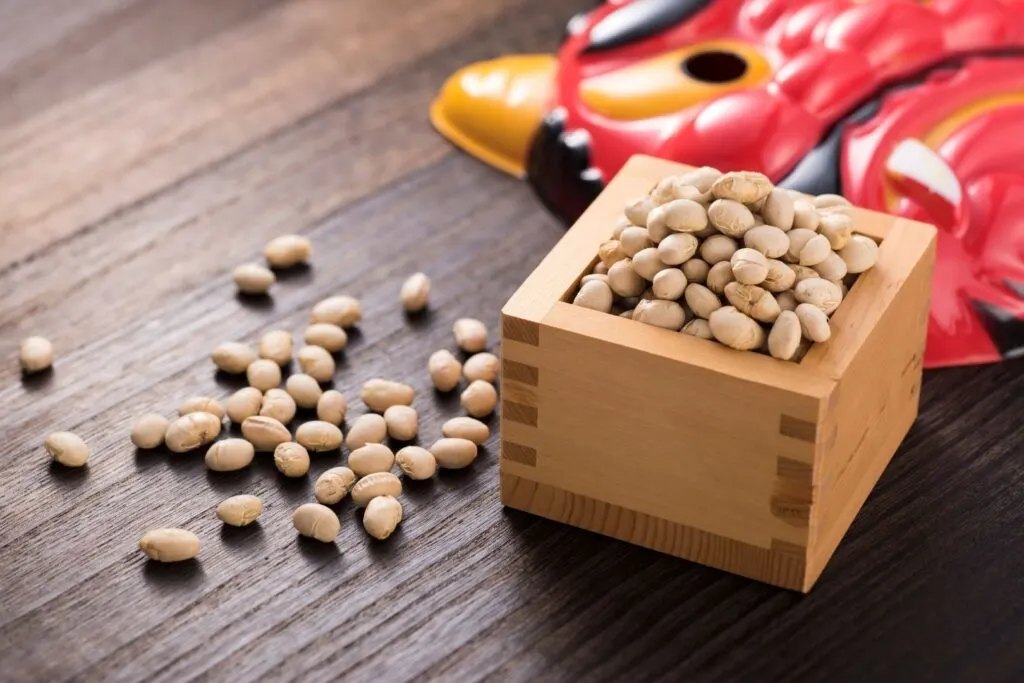
Traditionally the beans are put inside a wooden box called a masu, an old-style measuring cup that is also used for drinking sake, but taking them directly from the packet or other container is fine too. It’s considered especially auspicious for the toshi otoko, or a male member of the household who was born in the same year of the Chinese zodiac as the current year, to do the bean-throwing.
In the interests of gender equality, this has now been extended to toshi onna, girls or women with the same zodiac sign of the year. No matter when you were born, however, anyone can participate in bean-throwing and you can simply have fun with the ritual of dispelling bad luck and bringing good luck in.
The person dressing up as the demon can don a whole costume if they want to, but for private in-home mamemaki, the free supermarket oni masks received with your fukumame are the usual standard. Masks will often depict the red demon (aka oni), who represents greed. But there are actually five in total related to Setsubun, each one representing one of the Five Hindrances of Buddhism.
Ao oni (blue demon) symbolizes anger and misery, kiiro oni (yellow demon, but sometimes white) represents restlessness, midori oni (green demon) is lethargy and kuro oni (black demon) symbolizes indecisiveness.
The job of demon is often given to fathers who can expect to be bombarded with beans by their kids as they return home from the office. Once they have been successfully “driven out,” they re-enter the house, mask off, to enjoy the rest of the evening with their families.
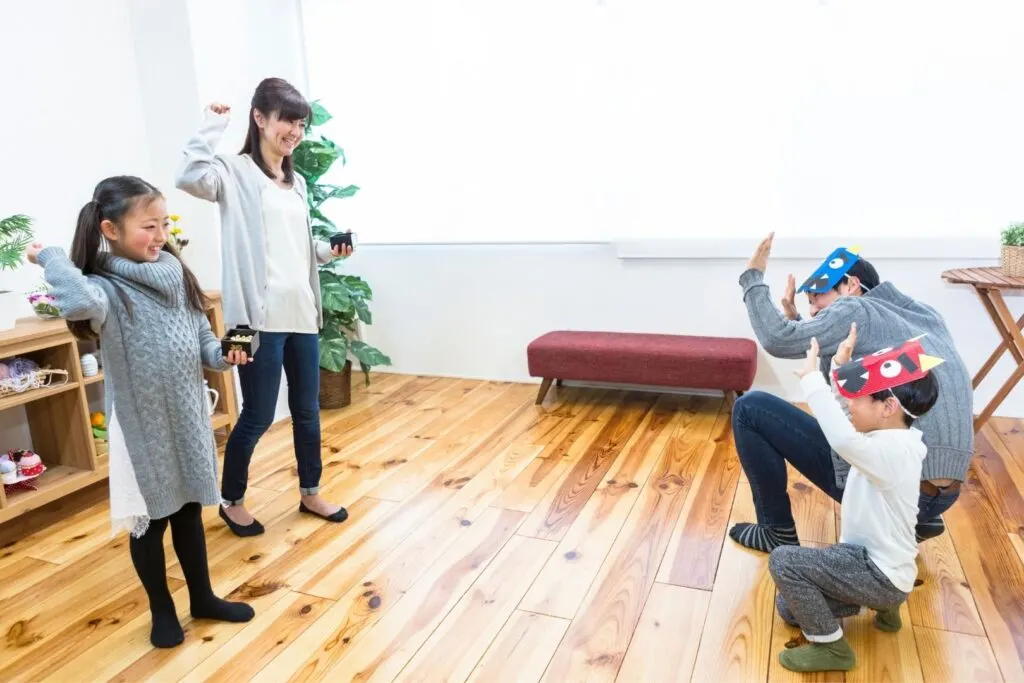
Alternatively, beans can simply be thrown at or out your door from the inside to perform this same ritualistic practice. Some people choose to do this ritual outside or on the street to avoid soy beans scattered inside their house. The expectation is, however, not to disturb others and clean up after yourselves in any shared space.
However and whoever you celebrate Setsubun with, don’t forget the magic words “Oni wa soto, fuku wa uchi!” as you throw the beans.
Public mamemaki events
At temples and shrines, mamemaki is usually an advertised public event that anyone who shows up can participate in.
Sumo wrestlers, interestingly enough, are often invited to take part. You won’t see them in action, but they will be wearing traditional robes and top-knots, and are often happy to pose for pictures and hold babies, a ritual that is associated with bringing good fortune in Japan. Elected officials and celebrities, especially when their zodiac signs align with the year, are also typical invitees.
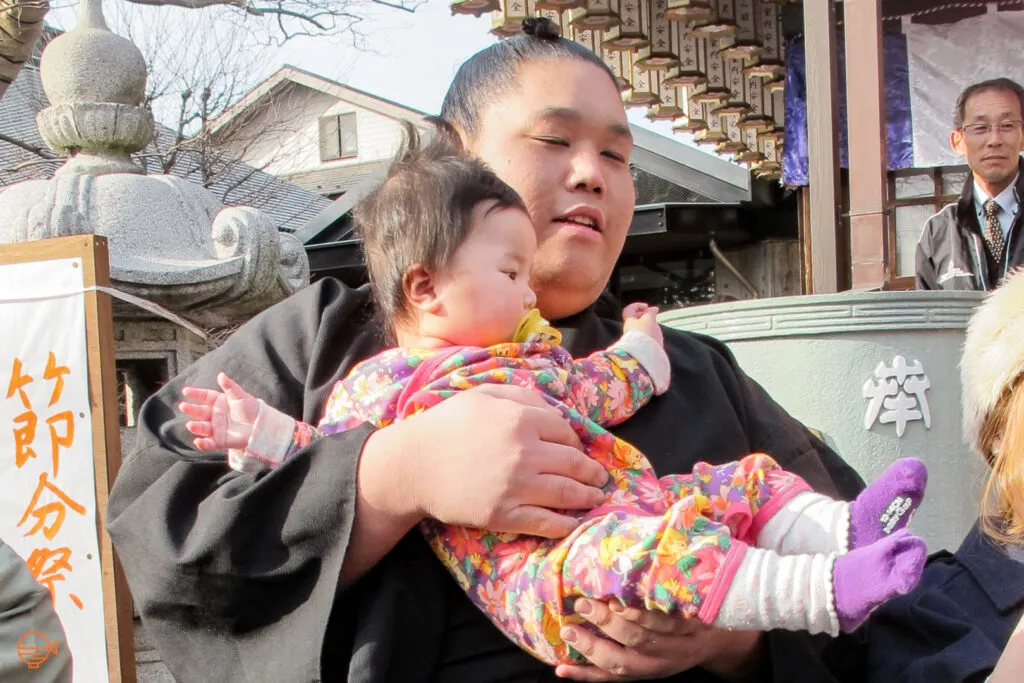
During the Setsubun proceedings, invited guests usually stand on the steps or on an elevated platform of the temple or shrine, and throw the fukumame at the “demon” when they appear, resulting in soy beans ending up all over the ground and into the crowd. It is usually an extremely short ritual – around 30 seconds – or as long as it takes for the people throwing to get through their portion of soy beans. So be sure to be on time!
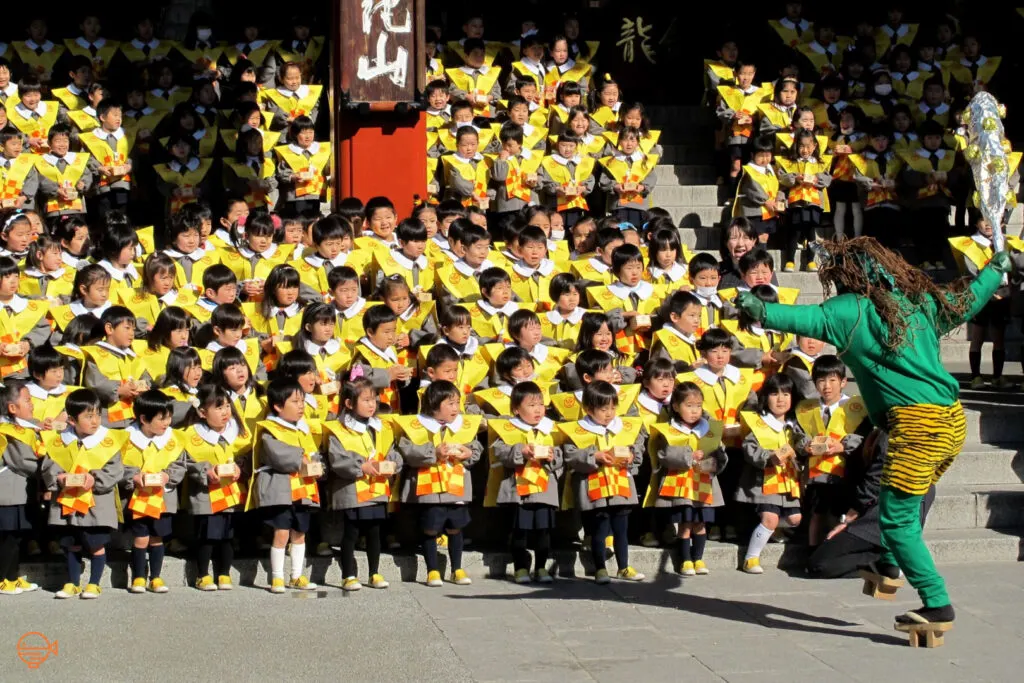
Food on Setsubun: Eating roasted soy beans
By this point you might be wondering, what happens to all these beans? Well, roasted soy beans are not just used for throwing on Setsubun, they are also eaten for good luck too. The traditional practice is to eat the number of soy beans corresponding to your age.
Either count out enough to put aside for this or be prepared to pick them up off your (hopefully) clean floor. At some public mamemaki events, where beans naturally end up all over temple grounds and streets (to be swept up later), you may encounter onlookers holding up plastic bags in an attempt to catch some before they hit the ground.
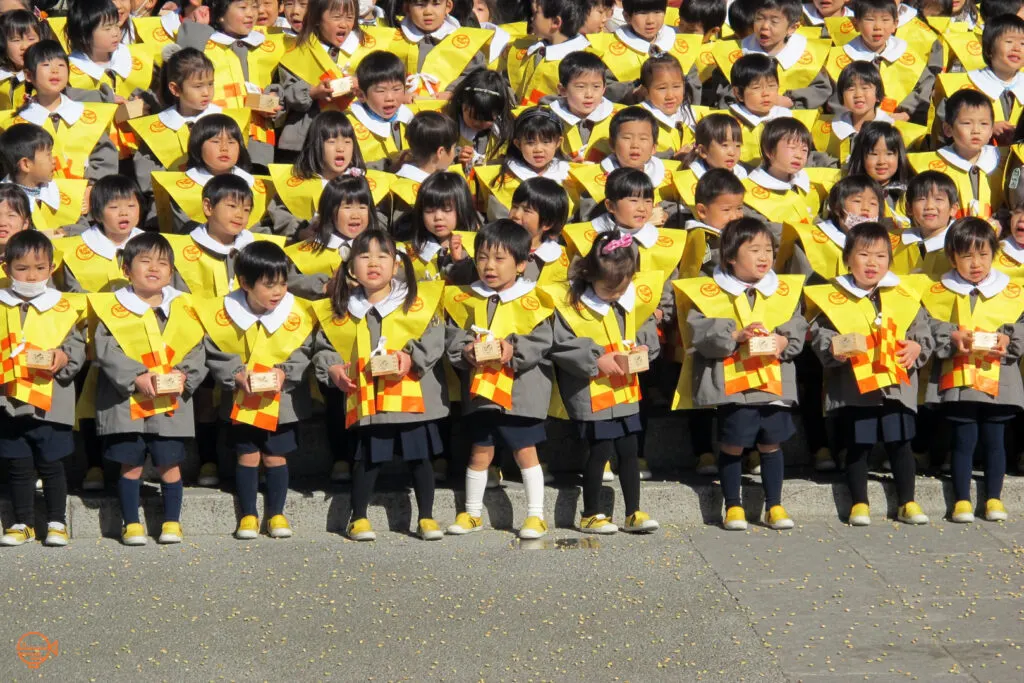
Sometimes the beans are handed out or thrown in plastic packets so that they can be picked up and eaten in a sanitary manner, which both doubles as a way to prevent food waste and as a convenient means of the event basically tidying up after itself.
In some instances, soy beans are switched out for peanuts still in their shells for the same reason. However, roasted soy beans are definitely the most common and traditional.
Sardines
Another food associated with Setsubun for its demon-repelling qualities is sardines.
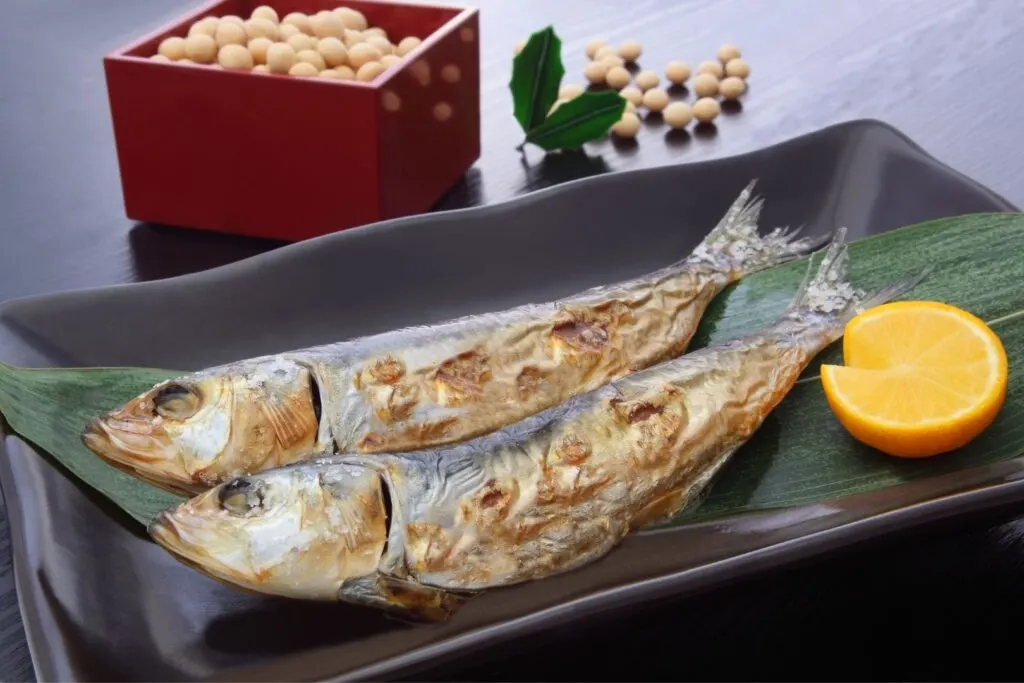
Around the 13th Century, prior to mamemaki, other methods were used to keep demons away and purify homes and places of religious importance on Setsubun through smell, smoke and noise, particularly burning dried sardine heads and wood, and banging drums while chanting.
Although not so common nowadays, some people still hang a sardine head and holly leaves to the exterior of their homes, usually by the entrance. Mostly found around Kanto and Nara, this is called Hiiragi Iwashi (柊鰯), literally ‘holly sardine,’ and is a cooked sardine head impaled on a holly branch. Oni are said to be repulsed by smelly fish and to be fearful of anything that could be used to stab them in the eye. Holly branches not only check that box but are a Shinto symbol in their own right.
Many people still eat sardines as part of their evening meal on Setsubun, and fish shops and supermarkets often decorate their displays with holly leaves for the celebration. If you want to make your own Hiiragi Iwashi talisman, locate some holly and save a sardine head from your meal, making sure to hang it well before midnight.
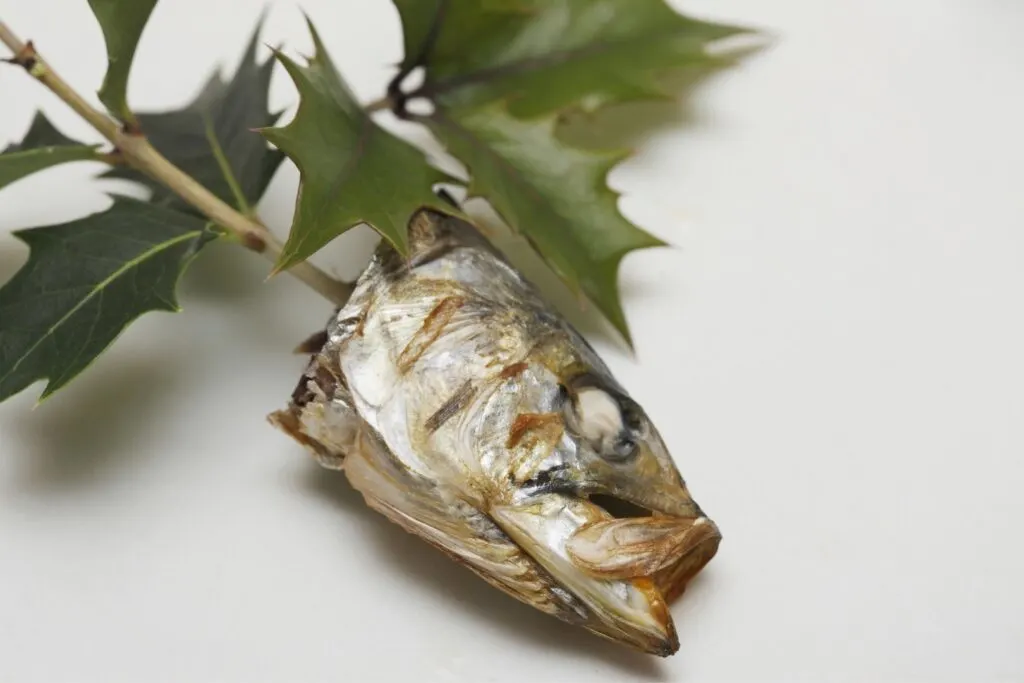
Ehomaki
On the evening of Setsubun, it is also customary to eat an uncut makizushi (sushi) roll known as ehomaki (ehōmaki, 恵方巻) or “lucky direction roll”.
The custom was once particular to the Kansai region, with its origins in Osaka, but has since become popularized in Kanto and all over the country thanks to excellent marketing by convenience stores and supermarkets.
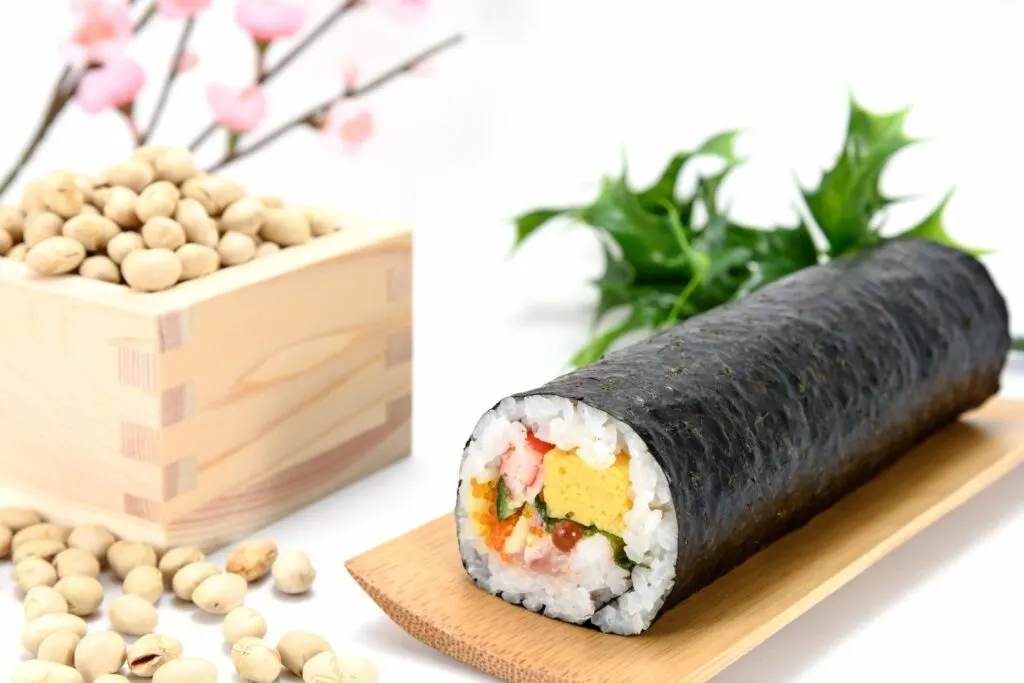
The sushi roll (vinegared rice wrapped in nori seaweed) is long and fat, and can be filled with any ingredients you’d like, but the number of fillings should number seven, to correspond with the Seven Deities of Good Fortune called Shichifukujin. Rolling up these seven ingredients is also said to be lucky. Additionally ehomaki must not be cut into bite-size pieces as that would mean cutting your good fortune.
There is a very specific way of eating ehomaki. For your wish to come true, it should be eaten in its entirety in silence while facing the good fortune direction of the year.
Lucky directions
2023: south-southeast
2024: east-northeast
2025: west-southwest
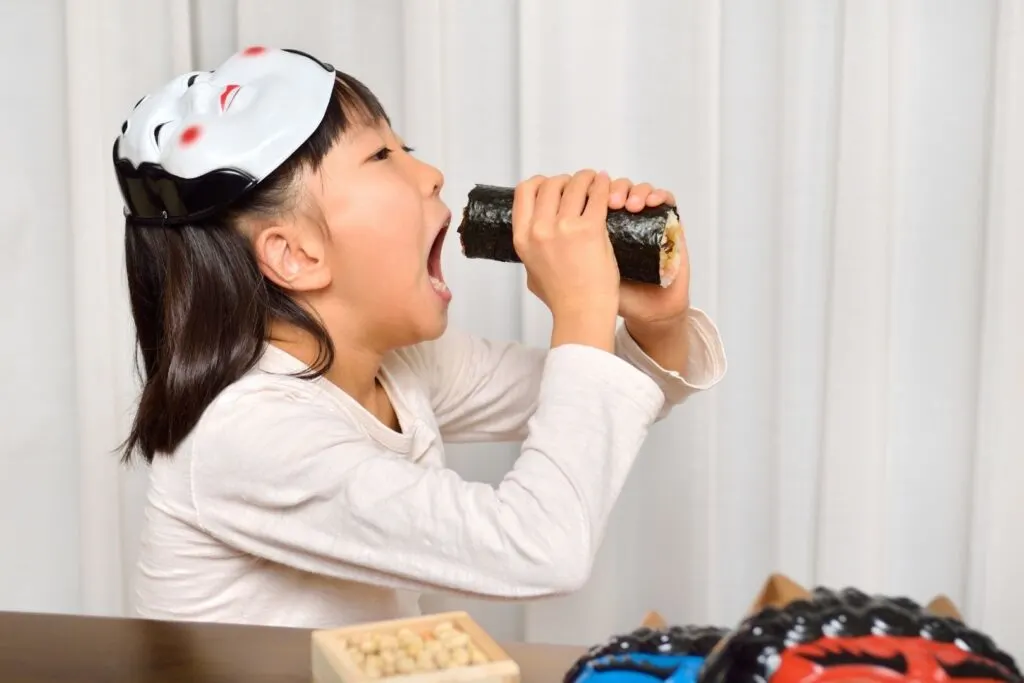
You can pre-order ehomaki from some convenience stores, supermarkets and sushi restaurants. The convenience store 7/11 has catalogues available with various types of ehomaki for pre-order. You can support convenience store workers by pre-ordering ehomaki as they usually have a quota to fill, which means if they don’t take enough orders they have to ask their families to buy up their quota or do so themselves, which can be quite a financial burden, especially for young students only working part-time.
There is usually a cut-off for orders, sometimes up to a week before, so be sure to be organized. That said, with ehomaki’s growing popularity, it is becoming increasingly easy to just walk in and buy one off the shelf on the day, especially if you go earlier on.
Ehonomi
A new way to celebrate Setsubun has emerged over recent years involving sake. Like ehomaki above, ehō refers to the lucky direction, but the ending has been switched for the word nomi, meaning to drink. You may have heard ‘nomi’ used in other compound words before such as nomihōdai (all-you-can-drink).
Just like ehomaki, you pour a cup of sake, turn to the lucky direction of the year and enjoy your drink without speaking while thinking of your wishes.
Setsubun is the season for new sake brews to become available, making the idea of ehonomi very inline with the Japanese appreciation of seasonal cuisine. Seeing the popularity of ehomaki, the practice of ehonomi was started by Tochigi Prefecture in 2016 as a way to promote the consumption of local sake.
Which Setsubun tradition would you most like to try?
Mark your calendars: While Setsubun typically falls on February 3rd, in 2021, Setsubun was celebrated on February 2nd, the first time the holiday has fallen a day earlier in 124 years.
The next time that will happen will be in 2025, after which it will occur every four years. Then in 2057 and 2058, we’ll have two consecutive years of Setsubun on February 2nd.
As for a Setsubun on February 4th, that won’t happen again until the 22nd Century.
Pin me for later
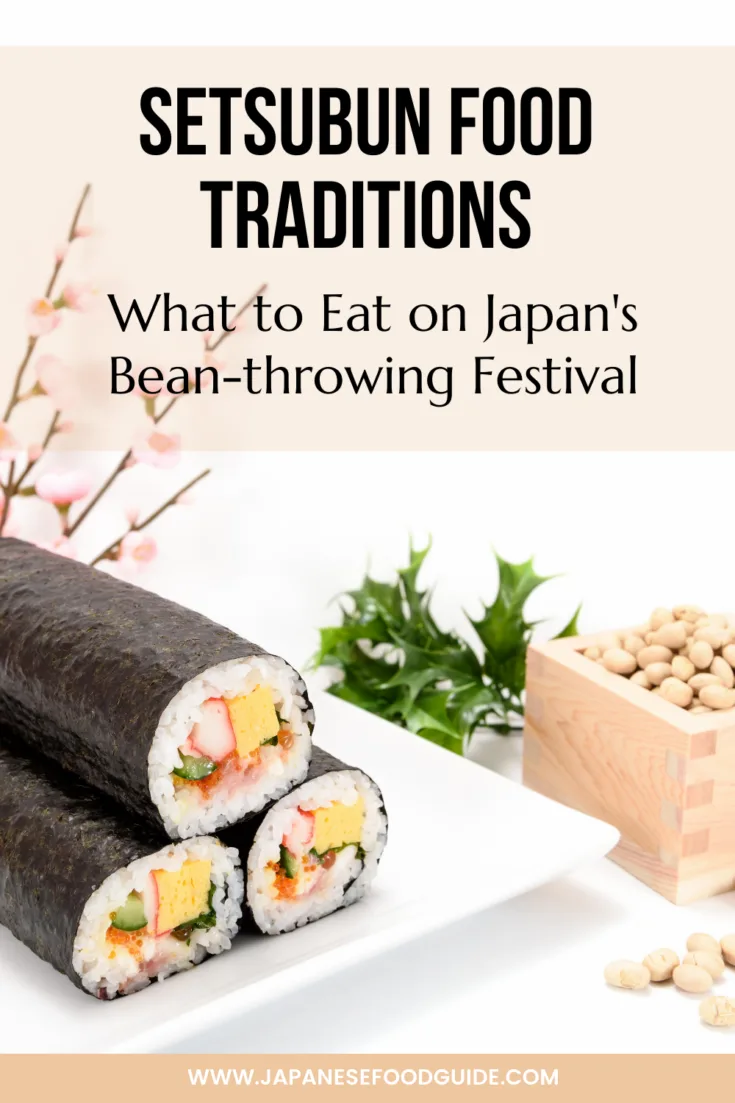
Jessica Korteman is a seasoned travel writer from Melbourne, Australia. She has spent a decade living, working and traveling in Japan, and specializes in Japanese culture, festivals and events, and travel destinations both on and off the beaten path throughout the country.
She is the Founder and Editor of Japanese Food Guide.
